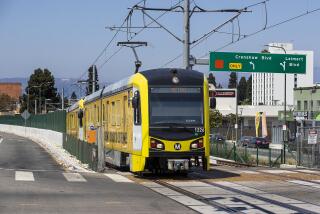Caltrans Offers Alternate Freeway Route
- Share via
Caltrans has come up with yet another variation of its proposed extension of the Long Beach Freeway that would run through the middle of town but save about half the historic structures threatened by other plans. This plan, appropriately enough, is dubbed the Meridian Variation.
What the name lacks in originality, the proposed route makes up in practicality, according to state Department of Transportation officials.
The so-called Meridian Variation would avoid 55 of the 106 historic buildings in the path of the original Meridian Route and wipe out 100 fewer dwellings. The original Meridian Route stretches from the end of the Long Beach Freeway in Alhambra through El Sereno and South Pasadena to an unfinished stub from the Foothill Freeway in Pasadena.
The variation would follow the original Meridian Route until it reaches Monterey Road, then loop two blocks west toward Orange Grove Boulevard before swinging back to the Meridian Route about 1.4 miles to the north at Arlington Street in Pasadena. Most of the change would be in South Pasadena.
9-Month Delay
The route change, which would delay the freeway at least another nine months while additional environmental studies are conducted, is being proposed to address concerns voiced by federal preservationists that routes previously considered by Caltrans--including the original Meridian Route the agency selected in 1984--would affect too many historic buildings.
The variation would avoid most of the historic residential districts north and south of Mission Street and entirely miss the Downtown Historic Business District along Mission. The original Meridian Route calls for a tunnel beneath the Mission business district and would go through the residential districts.
Caltrans is eager to complete the missing 6.2-mile segment of the Long Beach (710) Freeway to ease traffic congestion on north-south streets and to divert harbor-bound trucks from the overloaded Golden State Freeway. Besides the Meridian Route and the variation, the agency has considered the Westerly Route, which skirts the city’s western boundary, and six alternative routes designed to bypass historic structures.
But, for the 20 years, South Pasadena has resisted the Meridian Route in favor of the Westerly Route. And it was South Pasadena that leveled the strongest criticism of the new proposal.
Mayor Lee Prentiss said the latest proposal is unacceptable because it still would cut through the center of the city. Prentiss acknowledged that the altered route would avoid some historic buildings, but expressed some pique that Caltrans had not heeded concerns of local preservationists in years gone by.
“We’re just utterly amazed,” Prentiss said. “Why couldn’t they come up with that plan 20 years ago? The feds finally brought them to their knees. They moved it 900 feet to satisfy the federal advisory people (the Advisory Council on Historic Preservation). They wouldn’t listen to us, but they listened to them.”
The proposed route change would affect some of South Pasadena’s most prominent citizens.
David L. Margrave, a former South Pasadena city councilman, said the Meridian Variation runs right through the center of his turn-of-the-century, Craftsman-style house on Buena Vista Street.
“I don’t want the freeway to go that way but I don’t fear the freeway,” Margrave said. He believes Caltrans eventually will be forced to abandon the Meridian Route altogether.
Former Mayor Lila Cox said the original Meridian Route would have swallowed her swimming pool, but the variation would take her entire house. Cox, a longtime supporter of the Meridian Route and a neighbor of Margrave, said the variation would seriously damage the Buena Vista Street neighborhood, which has five nationally recognized Craftsman houses. But Cox said another proposal, the Westerly route that also would cross Buena Vista, would damage even more houses.
To Alhambra and Pasadena, which have urged speedy completion of the freeway, the prospect of another delay was not good news.
Disclosed April 18
Pasadena City Director Loretta Thompson-Glickman, a member of an advisory committee on the Long Beach Freeway route, said she was surprised by Caltrans’ latest proposal, which was disclosed at an April 18 meeting.
“That was an approved route,” she said of the original Meridian route. “They had all the public hearings . . . We really thought that was it. The delay, we’re not happy about it, but we have to accept that.”
Wayne Ballantine, chief of the environmental planning branch at Caltrans, said the agency has not yet officially altered the original Meridian Route. He said Caltrans will hold public hearings on the Meridian Variation in the fall and will include the changes in a draft environmental impact statement supplement it plans to submit to Federal Highway Administration officials in February.
Although Caltrans has long favored the Meridian Route and already has purchased about 500 parcels along it, freeway construction is not likely to start before the 1990s because of the route controversy and the amount of money needed to build, he said.
Ballantine acknowledged that Caltrans, which will need federal funding to help finance the $400-million freeway segment, was under some pressure from the federal Advisory Council on Historic Preservation.
“The advisory council had some very negative comments about the Westerly and the Meridian Route,” Ballantine said. “They recommended more studies be done. Largely as a result of that, we’ve been undertaking these studies. It certainly goes a long way in our mind toward showing we’ve done everything that’s reasonable as far as planning to minimize the harm to historical property.”
Robert Fink, director of the Western Regional Advisory Council on Historic Preservation, said that his organization had found all the previous Caltrans routes lacking and had recommended in 1984 that the project “not go forward, at least not with federal funds.”
More to Read
Sign up for Essential California
The most important California stories and recommendations in your inbox every morning.
You may occasionally receive promotional content from the Los Angeles Times.










